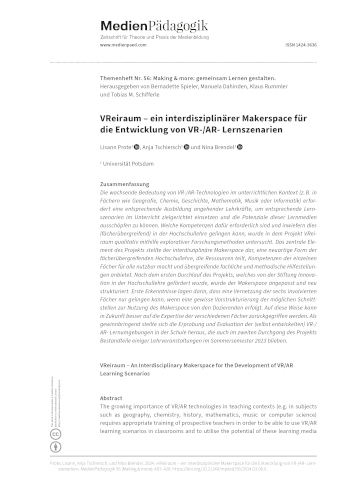Abstract
The growing importance of VR/AR technologies in teaching contexts (e.g. in subjects such as geography, chemistry, history, mathematics, music or computer science) requires appropriate training of prospective teachers in order to be able to use VR/AR learning scenarios in classrooms and to utilise the potential of these learning media in a meaningful sense. The project VReiraum used explorative research methods to qualitatively investigate the competencies which are required for this and the conditions for success to which this can be achieved (across disciplines) in university teaching. The central element of the project was an interdisciplinary makerspace, which has been adapted and restructured after the first run of the project. Initial findings showed that networking of the six involved subjects can only succeed, if the lecturers pre-structure possible interfaces for using the makerspace. In this way, the expertise of the various subjects can be better utilized in the future. Testing and evaluating (self-developed) learning scenarios in school has proven to be very important and remain a component of several courses in the second run of the project in summer 2023.
References
Beckmann, Astrid. 2022. «Zur Bedeutung von Augmented Reality im Mathematikunterricht der Sekundarstufen: Eine mathematikdidaktische Diskussion an zentralen unterrichtsrelevanten Aspekten». MedienPädagogik: Zeitschrift für Theorie und Praxis der Medienbildung 47 (AR/VR - Part 1): 53–75. https://doi.org/10.21240/mpaed/47/2022.04.03.X.
Bustamante Duarte, Ana Maria, Mehrnaz Ataei, Auriol Degbelo, Nina Brendel, und Christian Kray. 2021. «Safe Spaces in Participatory Design with Young Forced Migrants». CoDesign 17 (2): 188–210. https://doi.org/10.1080/15710882.2019.1654523.
Ehlers, Ulf-Daniel. 2020. Future Skills. Lernen der Zukunft – Hochschule der Zukunft. Zukunft der Hochschulbildung – Future Higher Education. Wiesbaden: Springer.
Hatch, Mark. 2014. The maker movement manifesto: rules for innovation in the new world of crafters, hackers, and tinkerers. New York: McGraw-Hill Education.
Helfferich, Cornelia. 2011. Die Qualität qualitativer Daten: Manual für die Durchführung qualitativer Interviews. 4. Aufl. Lehrbuch. Wiesbaden: VS.
James, E. Alana, Margaret T. Milenkiewicz, und Alan Bucknam. 2008. Participatory action research for educational leadership: using data-driven decision making to improve schools. Los Angeles: Sage Publications.
Kuckartz, Udo. 2018. Qualitative Inhaltsanalyse. Methoden, Praxis, Computerunterstützung. Weinheim: Beltz.
Kultusministerkonferenz KMK. 2017. Bildung in der digitalen Welt – Strategie der Kultusministerkonferenz. https://www.kmk.org/fileadmin/Dateien/pdf/PresseUndAktuelles/2018/Digitalstrategie_2017_mit_ Weiterbildung.pdf.
Kultusministerkonferenz KMK. 2021. «Lehren und Lernen in der digitalen Welt. Ergänzung zur Strategie der Kultusministerkonferenz ‹Bildung in der digitalen Welt›». 2021. Berlin: Kultusministerkonferenz.
Lamnek, Siegfried, und Claudia Krell. 2016. Qualitative Sozialforschung: mit Online-Material. 6., überarbeitete Auflage. Weinheim, Basel: Beltz.
Mayring, Philipp. 2016. Einführung in die qualitative Sozialforschung. Weinheim: Beltz.
McKenney, Susan, und Thomas C. Reeves. 2014. «Educational Design Research». In Handbook of Research on Educational Communications and Technology, herausgegeben von J. Michael Spector, M. David Merrill, Jan Elen, und M. J. Bishop, 131–40. New York, NY: Springer New York. https://doi.org/10.1007/978-1-4614-3185-5_11.
Mohring, Katharina, und Nina Brendel. 2021. «Producing Virtual Reality (VR) Field Trips – a Concept for a Sense-Based and Mindful Geographic Education». Geographica Helvetica 76 (3): 369–80. https://doi.org/10.5194/gh-76-369-2021.
Papert, Seymour, und Idit Harel. 1991. «Preface, Situating Constructionism». In Constructionism: research reports and essays, 1985–1990, herausgegeben von Idit Harel, Seymour Papert, und Massachusetts Institute of Technology. Norwood, N.J: Ablex Pub. Corp.
Prote, Lisann, Nina Brendel, und Anja Tschiersch (im Erscheinen). 2024. «VReiraum – ein interdisziplinärer Makerspace in der Hochschullehre im Spiegel der Future Skills». Zeitschrift für Hochschulentwicklung 19 (1), herausgegeben von Pascale Stephanie Petri, René Krempkow, Martin Ebner, Bernadette Spieler und Barbara Getto. Graz: fnma.
Radianti, Jaziar, Tim A. Majchrzak, Jennifer Fromm, und Isabell Wohlgenannt. 2020. «A Systematic Review of Immersive Virtual Reality Applications for Higher Education: Design Elements, Lessons Learned, and Research Agenda». Computers & Education 147 (April): 103778. https://doi.org/10.1016/j.compedu.2019.103778.
Schön, Sandra, und Martin Ebner. 2020. «Ziele von Makerspaces: Didaktische Perspektiven». In Lernwelt Makerspace, herausgegeben von Viktoria Heinzel, Tobias Seidl, und Richard Stang, 33–47. De Gruyter. https://doi.org/10.1515/9783110665994-004.
Shivers-Mcnair, Ann. 2021. Beyond the makerspace: making and relational rhetorics. Sweetland digital rhetoric collaborative. Ann Arbor: University of Michigan Press.
Southgate, Erica, Shamus P. Smith, Chris Cividino, Shane Saxby, Jivvel Kilham, Graham Eather, Jill Scevak, David Summerville, Rachel Buchanan, und Candece Bergin. 2019. «Embedding Immersive Virtual Reality in Classrooms: Ethical, Organisational and Educational Lessons in Bridging Research and Practice». International Journal of Child-Computer Interaction 19 (März): 19–29. https://doi.org/10.1016/j.ijcci.2018.10.002.
Stang, Richard. 2020. «Makerspace als Lehr- und Lernraum. Zur Gestaltung eines Optionsraums». In Lernwelt Makerspace: Perspektiven im öffentlichen und wissenschaftlichen Kontext, herausgegeben von Viktoria Heinzel, Tobias Seidl und Richard Stang, 48–56. De Gruyter. https://doi.org/10.1515/9783110665994.
Tillmann, Thomas, und Jan Schönfeld. 2021. Lernhacks: mit einfachen Routinen Schritt für Schritt zur agilen Lernkultur. München: Franz Vahlen.
Tschiersch, Anja, Manuel Krug, Johannes Huwer, und Amitabh Banerji. 2021. «Augmented Reality in Chemistry Education – an Overview». CHEMKON 28 (6): 241–44. https://doi.org/10.1002/ckon.202100009.
Westdeutscher Rundfunk. 2019. «Gegen das Vergessen – Zeitzeugen als Hologramm im Klassenzimmer», 18. Februar 2019. https://www1.wdr.de/unternehmen/der-wdr/unternehmen/augmented-reality-app-wdr-zeitzeugen-100.html.
Winter, Felix. 2020. Leistungsbewertung. Eine neue Lernkultur braucht einen anderen Umgang mit den Schülerleistungen. Bd. 49. Grundlagen der Schulpädagogik. Baltmannsweiler: Schneider Hohengehren.
Zender, Raphael, Josef Buchner, Caterina Schäfer, David Wiesche, Kathrin Kelly, und Ludger Tüshaus. 2022. «Virtual Reality für Schüler:innen: Ein ‹Beipackzettel› für die Durchführung immersiver Lernszenarien im schulischen Kontext». MedienPädagogik: Zeitschrift für Theorie und Praxis der Medienbildung 47 (AR/VR - Part 1): 26–52. https://doi.org/10.21240/mpaed/47/2022.04.02.X.

